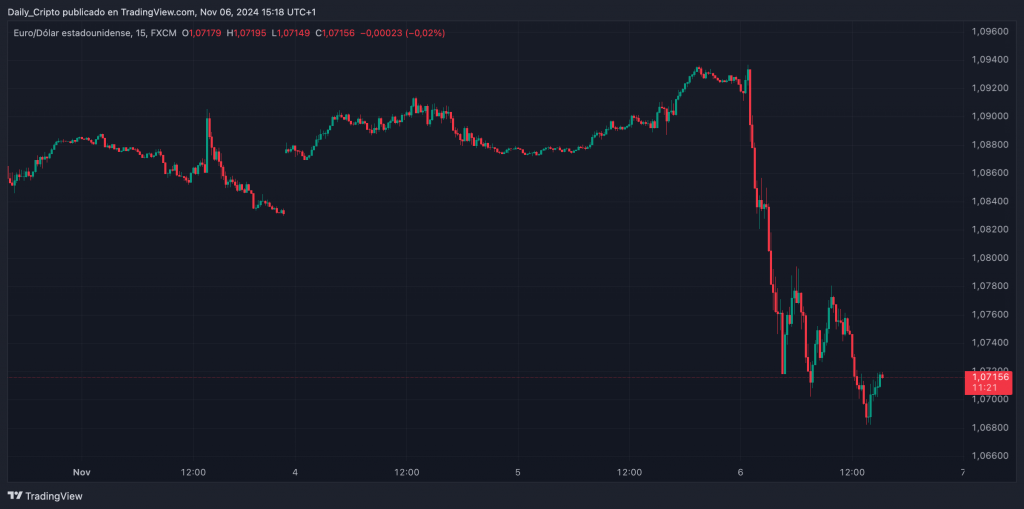
The EUR/USD currency pair is experiencing significant declines, poised for its largest single-day drop since the Brexit referendum in June 2016, largely influenced by economic fears following Donald Trump’s election win.
Market Reaction to Trump’s Election Victory: A Historical Decline for EUR/USD
The EUR/USD currency pair has seen a substantial drop today, marking its lowest levels since June. As of the latest updates, the pair has declined over 2%, which positions it for its most significant daily decline since June 2016, coinciding with the Brexit referendum.

This fall is particularly notable when compared to the market dynamics observed in March 2020, during the onset of the COVID-19 pandemic. The immediate impact of Trump’s election on the currency market reflects growing concerns about potential trade policies that could pressure the euro.
Analysts suggest that Trump’s administration may intensify trade tensions with the European Union, which could lead to the implementation of new tariffs. Such actions are expected to further strain the eurozone economy, which is already grappling with a sluggish growth outlook as it heads into the fourth quarter of this year.
The repercussions of Trump’s presidency appear to diverge significantly from the European Central Bank’s (ECB) strategies, potentially prompting quicker rate cuts by the ECB in response to worsening economic conditions in the euro area.
Macroeconomic Indicators and Currency Performance
Recent economic data signals varying performances across different currencies, with the USD demonstrating strength against the euro. As of the latest figures, EUR/USD is trading at approximately 1.07156, reflecting a 2% decrease.
In comparison, the USD/JPY pair has risen by 1.8%, reaching 154.40, supported by increasing U.S. Treasury yields, which are now up by 18 basis points to 4.46%. On a broader scale, the UK’s GBP/USD is down by 1.5% to 1.2850, while the USD/CAD has increased by 0.7% to 1.3920.
Notably, the Canadian dollar has shown relative resilience against the dollar’s surge. Meanwhile, the Australian dollar, represented by AUD/USD, is down by 1.2% to 0.6555. These movements illustrate a clear trend of the dollar outperforming other currencies in response to the election results and the anticipated economic implications.
It’s critical to highlight the broader economic landscape, as various macroeconomic indicators have been released. For example, the Eurozone reported a Producer Price Index (PPI) decline of 0.6% month-over-month, aligning with expectations.
Additionally, Germany’s industrial orders rose by 4.2% against an anticipated increase of 1.5%. These figures underscore the mixed signals within the eurozone economy, contributing to market volatility.
Equity Markets and Commodity Reactions
Equity markets have reacted positively to the news of Trump’s election victory, with U.S. futures indicating a strong upward momentum. The S&P 500 futures are up by approximately 2.1%, reflecting investor confidence despite the potential implications of Trump’s trade policies.
European equities have similarly benefited from this positive sentiment, despite initial concerns regarding tariffs and trade conflicts with the EU. Conversely, commodities such as gold and oil have experienced declines, indicative of a broader risk-on sentiment in the markets.
Gold has fallen by 1.6%, trading around $2,700.79, while WTI crude oil prices have dropped by 1.4% to $70.98 per barrel. Such movements can be attributed to the shift in investor focus toward equities and the anticipated economic policies of the incoming Trump administration.
Cryptocurrency markets have shown a contrasting trend, with Bitcoin experiencing a significant rise above $75,000. This surge is likely linked to Trump’s positive stance on cryptocurrencies during his campaign, signaling a potential for more favorable regulatory environments in the future.
Conclusion
In summary, the aftermath of Donald Trump’s election win has led to pronounced shifts in the currency market, particularly affecting the EUR/USD pair. The potential for intensified trade tensions and its implications for monetary policy in both the eurozone and the United States are pivotal concerns for investors.
Current data indicates a strong dollar performance, alongside notable fluctuations in equity and commodity markets, as market participants adjust to the new political landscape. The ongoing developments in macroeconomic indicators and their impacts on various currencies will continue to shape market trends in the coming months.
Disclaimer: All information provided on this website is for informational purposes only and should not be construed as financial or investment advice. We do not guarantee the accuracy, completeness, or timeliness of the information, and we are not responsible for any financial decisions you may make based on this information. Cryptocurrencies are highly volatile assets, and any investment in them carries a high level of risk.
More Like This

US Manufacturing PMI Rises to 49.7 in November

PCE Inflation Comes In-Line With Expectations
*AI technology may have been used to develop this story and publish it as quickly as possible.

